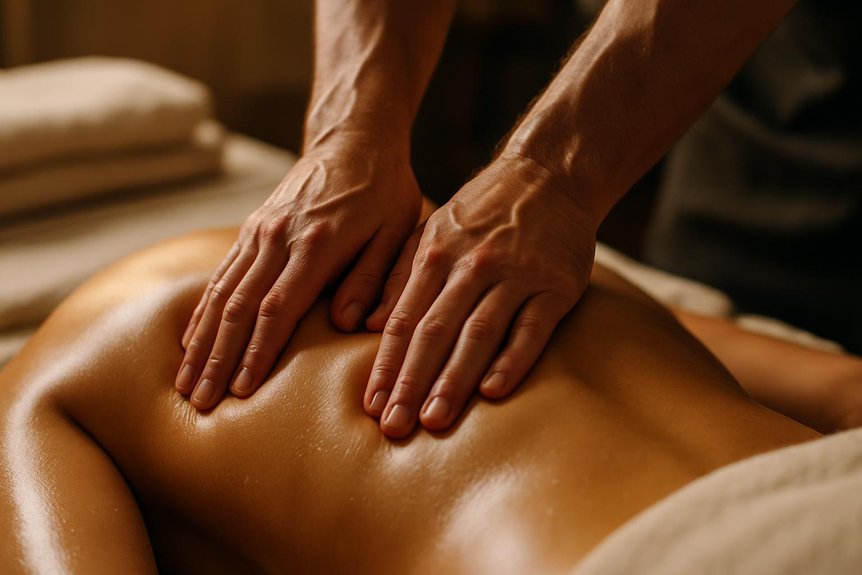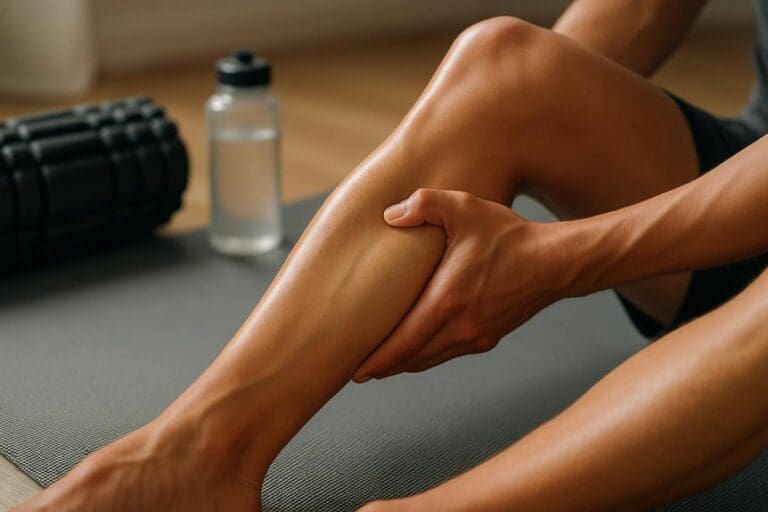This therapy applies sustained, anatomically targeted pressure to disrupt restrictive muscular adhesions and address deeply embedded myofascial tension. This technique enhances local circulation, facilitates metabolic waste removal, and restores tissue pliability, providing relief for chronic musculoskeletal discomfort and postural imbalances. Evidence-based manual therapies—including myofascial release and deep friction—support tissue healing and functional recovery. For individuals seeking an in-depth understanding of its mechanisms and therapeutic applications, further information is available below.
How This Therapy Targets Muscular Tension

This therapy employs sustained pressure and slow, deliberate strokes to access the deeper layers of muscle fascia and connective tissue, effectively addressing areas of chronic muscular tension.
In clinical practice at Spa & Massage, therapists utilize anatomical mapping to identify myofascial adhesions and localized hypertonicity. By applying targeted manual techniques, the therapist disrupts restrictive patterns within the muscular architecture, facilitating the release of tension stored within the deeper musculature.
This process invokes a physiological response—enhanced local circulation and improved tissue pliability—allowing the body to shift from rigidity to a state of receptive relaxation.
The intimate, attentive approach adopted by Spa & Massage practitioners ensures that each manipulation respects individual thresholds, gently coaxing the body toward ideal muscular balance and a renewed sense of physical ease.
As one of the key benefits of deep tissue massage, this method not only targets muscular tension but also promotes long-term relief from chronic discomfort.
Benefits for Chronic Pain and Injury Recovery
How does targeted manual therapy support chronic pain management and injury rehabilitation? This therapy utilises sustained pressure aimed at deeper layers of muscle fascia, addressing adhesions and chronic tension.
Clinical evidence suggests this approach promotes myofascial release, enhances circulation, and disrupts nociceptive pathways associated with persistent pain.
At Spa & Massage, therapists assess postural imbalances and biomechanical dysfunctions before focusing on affected muscle groups, such as the lumbar region for lower back pain or the rotator cuff for shoulder injuries.
This modality may accelerate recovery by reducing local inflammation, improving tissue pliability, and facilitating lymphatic drainage.
Clients experiencing repetitive strain or post-injury discomfort often report diminished pain intensity and increased range of motion, supporting a return to daily activities with greater ease and comfort.
Techniques Used by Our Therapists
Therapeutic outcomes for chronic pain and injury recovery rely on the application of precise manual techniques targeting musculoskeletal dysfunction. At Spa & Massage, therapists employ anatomically informed strokes such as slow, sustained pressure and deep friction along muscle fibers and fascia.
Myofascial release, cross-fiber mobilization, and trigger point therapy are frequently utilized to address adhesions and hypertonic tissue. The practitioner’s tactile sensitivity guides pressure and direction, adapting to each client’s unique tissue density and response.
Palpation identifies areas of restriction or tenderness, allowing for focused intervention on deep muscle layers without sacrificing client comfort. Through these advanced techniques, Spa & Massage therapists facilitate increased circulation, reduction of myofascial tension, and restoration of ideal tissue pliability, supporting deeper connection and healing within the body.
What to Expect During Your Session
Upon arrival at Spa & Massage, clients undergo an initial assessment to document medical history, current symptoms, and therapeutic objectives. The therapist evaluates musculoskeletal imbalances, palpates areas of myofascial tension, and discusses specific regions of discomfort.
Using anatomically informed techniques, the session targets deeper layers of muscle and connective tissue. Clients may experience slow, sustained pressure and friction along muscle fibers and fascia. Communication is encouraged to calibrate pressure and guarantee ideal comfort.
The environment remains serene, with professional draping maintaining privacy. Sessions are tailored, focusing on resolving chronic muscular adhesions and promoting neuromuscular relaxation.
Throughout treatment, the therapist monitors tissue response, encouraging deep breathing to facilitate relaxation and enhance therapeutic outcomes.
Aftercare Tips for Lasting Results
Following the application of targeted, anatomically precise techniques during a session at Spa & Massage, appropriate post-session protocols are essential to optimise physiological recovery and prolong therapeutic benefits.
Immediate hydration is strongly recommended to facilitate metabolic waste removal from the soft tissues.
Gentle stretching, as prescribed by Spa & Massage therapists, helps maintain myofascial elasticity and reduce the risk of post-treatment stiffness.
Thermotherapy, such as a warm bath, may support vasodilation and tissue oxygenation.
Clients are advised to avoid intense physical exertion for 24 hours, allowing the musculoskeletal system adequate time to adapt.
Any transient soreness should be addressed with rest or ice application.
Adhering to these evidence-based aftercare recommendations enhances tissue repair, encourages neuromuscular relaxation, and sustains the intimate, restorative results experienced at Spa & Massage.
Conclusion
This therapy alleviates chronic musculoskeletal pain, enhances functional mobility, and facilitates myofascial release. By targeting deep muscle layers, reducing inflammatory biomarkers, and improving vascular perfusion, this modality promotes ideal tissue healing. Clients can expect targeted intervention, measurable relief, and sustained physiological benefits. Through clinical expertise, anatomical precision, and personalised care, Spa & Massage delivers evidence-based outcomes—restoring function, minimising discomfort, and supporting holistic recovery for individuals seeking lasting musculoskeletal health and improved quality of life.



